Thursday, 4th August 2022
India’s One-China stand and relations with Taiwan
In News
The US House Speaker has arrived in Taiwan with India keenly watching the developments.
Understanding One-China Policy and India’s Policy towards Taiwan
- ‘One China’ policy is the diplomatic acknowledgement of China’s position that only one Chinese government exists.
- Under the policy, a country should recognise and have formal ties with China rather than the island of Taiwan, which China sees as a breakaway province to be reunified with the mainland one day.
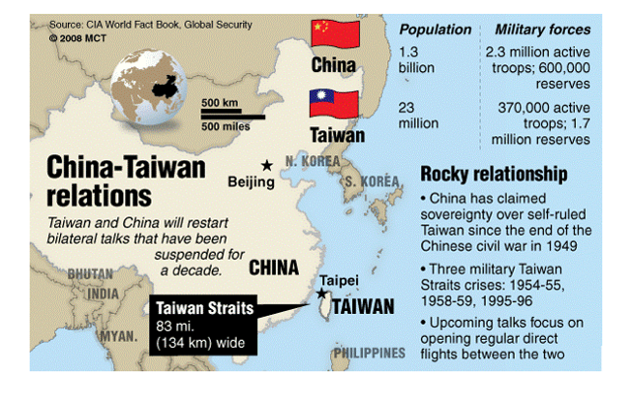
- The policy is a fundamental bedrock of Chinese policy-making and diplomacy.
- However, it is distinct from the One China principle, whereby China insists Taiwan is an inalienable part of one China to be reunified one day.
India’s Policy towards Taiwan
|
About Taiwan
Present Status:
Importance of Taiwan:
|
- India also follows One China Policy and it does not have formal diplomatic ties with Taiwan.
- But it has an office in Taipei for diplomatic functions- India-Taipei Association (ITA) and Taiwan has the Taipei Economic and Cultural Center (TECC)in New Delhi.
- The Indo-Taiwanese ties basically is focused on trade, commerce, culture, and education.
- In recent times, after China’s belligerence in Galwan, India has stepped up its relationship with Taiwan.
India–Taiwan relations
- Bilateral relations: They have improved since the 1990s, despite both nations not maintaining official diplomatic relations.
- Cultural exchanges: Buddhism is the most widely practised religion in Taiwan, usually alongside elements of Daoism, and Bollywood films have in recent years gained a reasonably popular following, along with other aspects of Indian culture such as yoga, cuisine and Indian dance.
- Trade: Taiwan’s relations with India have increased in breadth spanning trade, research and academia, as well as depth trade ties, which amounted to $7.5 billion in 2019, up from $1 billion in 2000.
- Taipei Economic and Cultural Center in India (TECC): TECC oversees the collaboration on different fronts like education, tourism, culture, the media, and economic development.
- Free trade Agreement: India has suggested the possibility of a free trade agreement with Taiwan, as Taiwan maintains economic cooperation agreements (ECAs) with New Zealand and Singapore, both unofficial relationships.
Source:
Explained: India’s One-China stand and relations with Taiwan
25 Years of Indo-Naga Ceasefire Agreement (1997-2022)
In News:
The Indian Government has recently signed a “historic peace agreement” with the Nationalist Socialist Council of Nagaland (NSCN-IM), the Naga outfit named after its two leaders, Isak Chishi Swu and Thuingaleng Muivah.
About the News:
- The National Socialist Council of Nagalim (Isak-Muivah) observed 25 years of signing the “Indo-Naga” ceasefire agreement in Nagaland.
- The ceasefire agreement between the Government of India and the NSCN-IM came into effect on August 1, 1997.
- After multiple rounds of talks, a “Framework Agreement” with the NSCN-IM was signed in 2015 aiming to pave the way for peace in Nagaland and the Naga-inhabited areas beyond in three adjoining States in the northeast.
- However, the peace process has so far failed apparently due to the disagreement between the two parties over the Naga flag and the Yehzabo (Naga constitution), which the NSCN (I-M) insists were incorporated in the Framework Agreement.
What is the Naga issue?
- Background: The Naga tribes are said to have migrated from southwest China to Burma (now Myanmar) and Thailand, eventually settling in North East India and North West Myanmar.
- Identification by the British: The term Naga was created by the British for administrative convenience to refer to a group of tribes with similar origins but distinct cultures, dialects, and customs accumulated in Nagaland, Arunachal Pradesh, Manipur, and Myanmar.
- Historical claim: Many Naga groups including the NSCN (IM) claimed that Nagas were never part of India and had even declared Independence on August 14, 1947, soon after the British had left India.
Evolution of Naga peace accord:
- NSCN(I-M): It is one of the oldest and most powerful of about 30 rebel groups in northeast India, was earlier fighting for an independent homeland for the Nagas.

- Split in the organisation: In 1988, after years of infighting and violent clashes along tribal lines and over the main cause of the movement, the NSCN split into two factions one, the NSCN-IM led by Isak and the other, the NSCN-K led by Kaplang.
- De facto representative: In 1990, the NSCN-IM became the most powerful insurgent group, also playing a role in the creation of smaller groups in other states.
- Over the years, it has scaled down the demand to a Greater Nagaland, to be formed by slicing off parts of adjoining states that have Naga tribal populations.
- It signed a formal ceasefire agreement with the Centre in 1997 and later a framework agreement with the NSCN-IM in 2015 to find a solution to the Naga political issue.
- The NSCN-IM continues to demand ‘Greater Nagaland’ or Nagalim — it wants to extend Nagaland’s borders by including Naga-dominated areas in neighbouring Assam, Manipur and Arunachal Pradesh, to unite 1.2 million Nagas.
Source:
Wild Life (Protection) Amendment Bill, 2021
In News:
The Wild Life (Protection) Amendment Bill, 2021 has been recently passed by Lok Sabha to amend the Wild Life (Protection) Act, 1972.
Key features of Amendment Bill
- CITES: The Bill seeks to implement certain provisions of the Convention on International Trade in Endangered Species of Wild Fauna and Flora (CITES), relating to species classification, and regulating the trade of all listed specimens through permits.
Rationalising Schedules: The Bill reduces the total number of schedules to four (from the present six ) by:
-
- Reducing the number of schedules for specially protected animals to two (one for greater protection level)
- Removing the schedule for vermin species, and
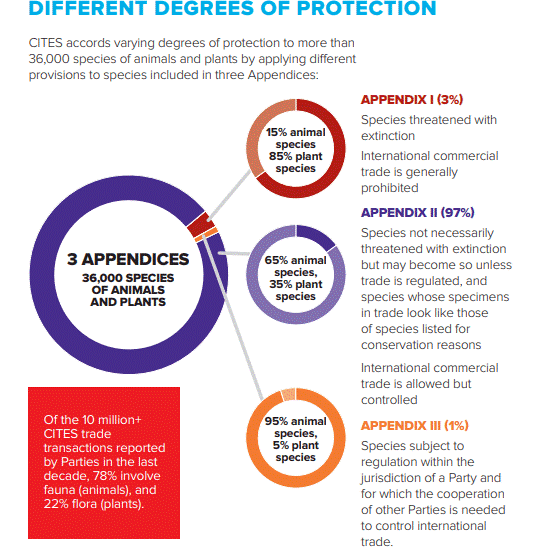
- Inserting a new schedule for specimens listed in the Appendices under CITES (scheduled specimens).
- Obligations under CITES: The Bill provides for the central government to designate a:
- Management Authority, which grants export or import permits for the trade of specimens, and
- Scientific Authority, which gives advice on aspects related to impact on the survival of the specimens being traded.
- Invasive alien species: The Bill empowers the central government to regulate or prohibit the import, trade, possession or proliferation of invasive alien species.
- Control of sanctuaries: The present act entrusts the Chief Wild Life Warden to control, manage and maintain all sanctuaries in a state. The Bill specifies that the actions of the Chief Warden must be in accordance with the management plans for the sanctuary.
- Conservation reserves: Currently, state governments may declare areas adjacent to national parks and sanctuaries as conservation reserves. Now, the Bill empowers the central government to also notify a conservation reserve.
- Surrender of captive animals: The Bill provides for any person to voluntarily surrender any captive animals or animal products to the Chief Wild Life Warden. No compensation will be paid to the person for surrendering such items. The surrendered items become the property of the state government.
- Penalties: The Act prescribes imprisonment terms and fines for violating the provisions of the Act.
- State Board for Wild Life: The 2021 Bill empowers the State Board for Wild Life to constitute a Standing Committee, for exercising certain delegated powers and duties.
Concerns associated with Amendment
- The Standing Committee observed that amending the Biological Diversity Act, 2002 would be the most appropriate way of implementing CITES, as it observed that the approach under the Bill will make the principal Act complicated and might introduce contradictions.
- The Committee noted that the Standing Committee will be packed with official members, and may end up being a rubber stamp for faster clearances of projects.
- The Bill exempts the transfer of certain live elephants from the permission requirement. To discourage private ownership and trade in elephants, the Committee recommended that this exemption should be removed.
Source
The Wild Life (Protection) Amendment Bill, 2021
Standing Committee Report Summary
Lok Sabha passes Wild Life (Protection) Amendment Bill, 2021. What it means.
Image source
Chandler Wobble - Edukemy Current Affairs
- Context: The Earth has recently completed one rotation in 1.59 milliseconds less than 24 hours thereby setting the record for the shortest day ever recorded since scientists began using atomic clocks to measure its rotational speed.
- The Chandler Wobble refers to a small deviation in the Earth’s axis of rotation relative to solid earth.
- Scientists studying the Earth’s rotation use a measurement called “length of day” to describe how fast or slow the planet is spinning.
- Length of the day is the difference between the time the planet takes to complete one rotation on its axis and 86,400 seconds (24 hours).

- When the length of the day is a positive number and rising, the Earth is spinning slower and vice versa.
- In 2020, the planet achieved its 28 shortest recorded days in the same year.
- Even though the shortest day of 2021 was fractionally longer than the shortest of 2020, in 2022, it looks like the Earth has sped up again.
Source:
Earth sets record for shortest day as it speeds up rotation
Image source:
Earth sets record for shortest day as it speeds up the rotation
Creation of new districts - Edukemy Current Affairs
-
- Context: The West Bengal government has created 7 new districts in the state taking the total tally to 30.
- The power to create new districts lies with the state governments, who can pass a law in the Assembly or simply issue an order and notify it in the gazette.
- Although the central government has no role in the creation of new district, it plays a role, however, when a change of name of a district or railway station is contemplated.
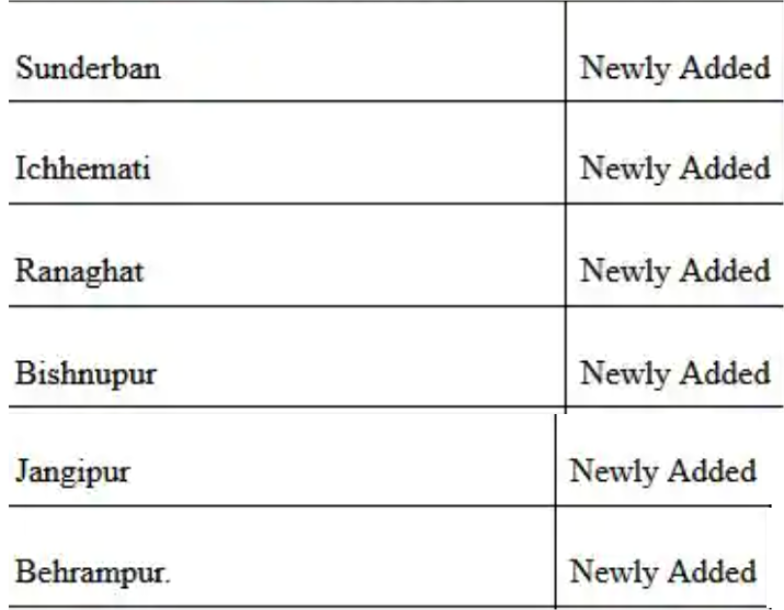
- The request of the state government in this regard is sent to several central government departments before a no-objection certificate is issued.
- New districts are created from time to time to make governance easier and benefit the people by bringing the government and the administration closer to them and making them more accessible.
- Uttar Pradesh has the most districts (75) in the country, followed by Madhya Pradesh (52).
- Goa, by contrast, has only 2 districts. However, the number of districts in a state is not always a function of the area of the state, or of its population.
Sources:
Image source:
https://www.wionews.com/india-news/west-bengal-introduces-7-new-districts-check-full-list-502582
Guidelines for Shaksham Anganwadi and POSHAN 2.0
- Context: The Ministry of Women and Child Development Ministry has recently released new guidelines for 'Saksham Anganwadi and Poshan 2' making Aadhaar registration mandatory for all Anganwadi schemes.
- Anganwadi Services Scheme is now open to all eligible beneficiaries with one pre-condition of the beneficiary being registered with Aadhaar identification
- The guidelines are however not mandatory for children for availing benefits under the Anganwadi Services Scheme and the same can be accessed using the mother's Aadhaar card.
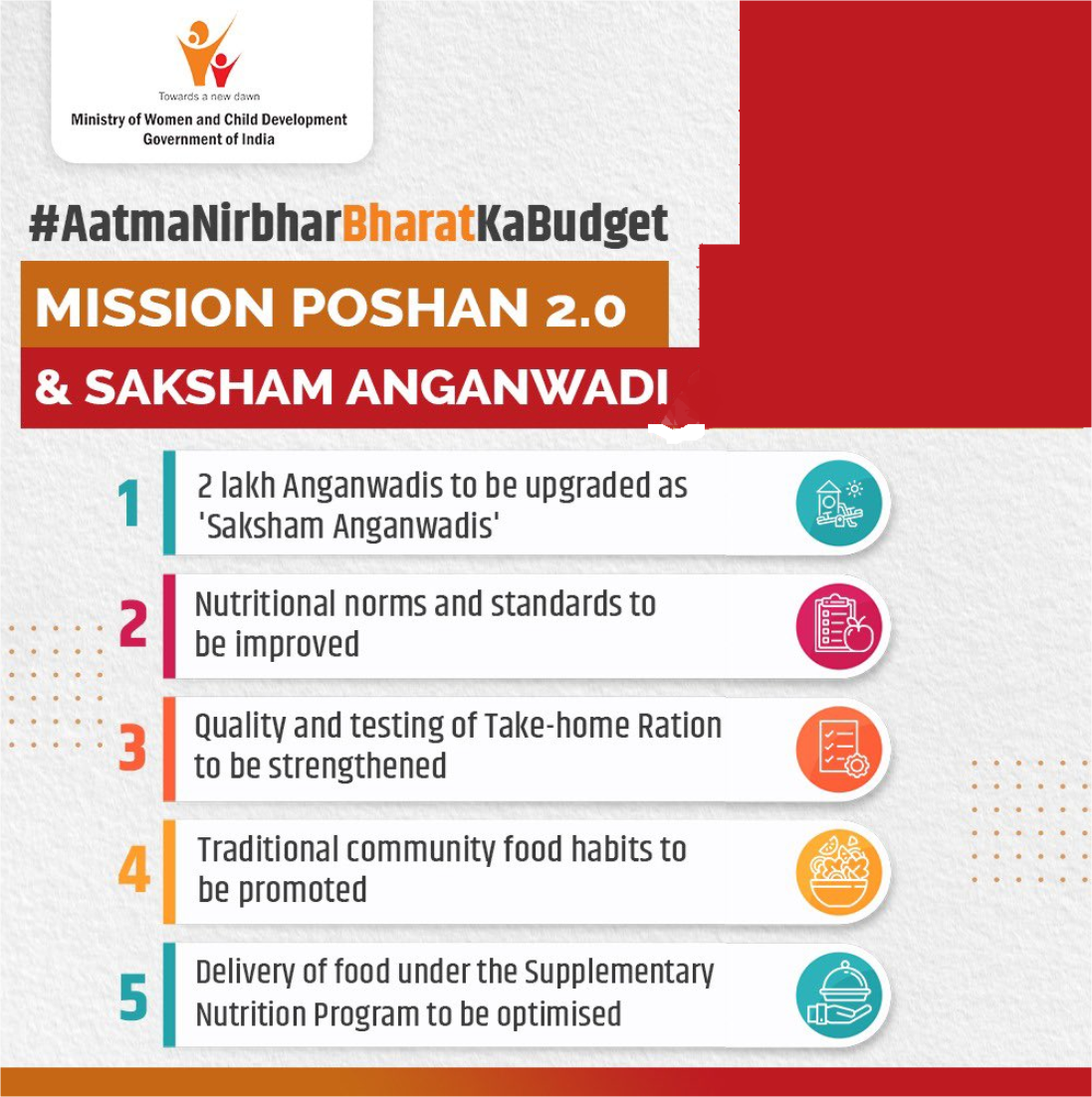
- Under the 'Scheme for Adolescent Girls', the beneficiaries for the scheme will be girls in the age group of 14-18 years who will be identified by the states concerned.
- Under 'Poshan 2.0', the scheme for adolescent girls has been revised, and the targeted beneficiaries now comprise girls in the age group of 14 to 18 years in aspirational districts of states, including Assam and the northeastern states, instead of out-of-school girls in the age group of 11-14 years earlier.
- The evaluation of the scheme shall be conducted by a third party of repute to be nominated by the Ministry of Women and Child Development.
Image source: https://twitter.com/smritiirani/status/1488464463007080449
Vilayati kikar - Edukemy Current Affairs
- Context: The Delhi Forest and wildlife department will be carrying out pruning of the invasive species- vilayati kikar from a 20-hectare area of the Central Ridge, by simultaneously growing native Aravalli species next to them as part of an eco-restoration project.
- The long-term plan of the project is to remove the invasive species from around 7,500 hectares of forest land across Delhi.
- Vilayati kikar (Prosopis juliflora) is an invasive tree species introduced under the British Empire in the 1930s (native to Mexico, South America and the Caribbean) as part of development of Delhi.
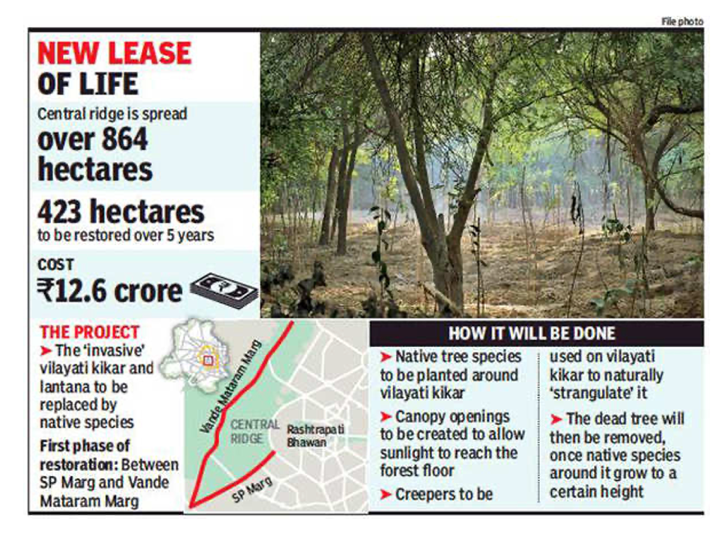
- The tree does not let other trees flourish in the area, because of its deep roots and it monopolises water and sunlight in the area.
- These trees can dry up underground aquifers through its deep-root system, going as far as 20 metres or more in search of water, significantly higher than around 5 metres that native shrubs and trees go.
- It has a thick canopy and does not allow sunlight to reach the floor of the area where they are planted.
- An invasive species is an organism that causesecological or economic harm in a new environment where it is not native. Invasive species can cause extinctions of native plants and animals, reducing biodiversity, competing with native organisms for limited resources, and altering habitats.
Source;
https://indianexpress.com/article/cities/delhi/vilayati-kikar-central-ridge-7890921/
Image source:
Reaping the demographic dividend: The Hindu
Essence – The article talks about India’s demographic position in the world with respect to China with reference to the World Population Prospects 2022. It highlights the view of various think tanks across the globe about India’s potential in terms of its demographic dividend. It also compares Indian society with that of China at the time of economic take-off. It also highlights that India does not have that deep a rural-urban divide which plagues the Chinese society due to their Hukou system. Ultimately, it suggests that to reap the demographic dividend, India must invest in education and health infrastructure.
Why should you read this article?
- To know about the potential of India’s demographic dividend.
- To know how better is India’s position in its economic take-off stage vis-à-vis China.
Source - https://www.thehindu.com/opinion/op-ed/reaping-the-demographic-dividend/article65720792.ece
Letting jobless growth worsen is way too risky: Live Mint
Essence- The article highlights the scenario of jobless growth in India, where despite the increasing GDP, the employment generation is low. This has resulted in a condition where the labour force out of farms is forced to look for alternate labour in the construction sector.
The article states that the reason behind such growth is India’s transition from the primary sector directly to the service sector. The rise in the service sector did create jobs initially but these are available only to the well-educated. On the other hand, the manufacturing sector has not grown to the extent needed, leading to a dramatic gap between job seekers and job availability.
The article states that therefore, in the post-pandemic era, there is a need to diversify the supply chain away from China. This presents an opportunity for the development of the manufacturing sector in India. Thus the article lays emphasis on the need to look into improving our infrastructure, skill development, hidden costs, ease of business, and licensing.
Why should you read this article?
- To know about the present state of employment in the economy.
- To understand the dynamics of jobless growth in India.
Source:
Bengaluru Home: Solar-Powered, Rain-Harvesting, Cool
Background
A Bengaluru-based couple's house, that harvests solar energy and rainwater while staying much cooler, due to its eco-friendly architecture, was in news recently.
About Sustainable Housing
- Sustainable homes, also known as 'Green homes', aim at economic, social and environmental sustainability from planning to the implementation phase.
- The features that make housing sustainable include efficient use of energy, water and other resources, use of renewable energy, such as solar energy, use of materials that are non-toxic, ethical and sustainable, consideration of the environment in design, construction and operation, a design that enables adaptation to a changing environment etc.

- Benefits of sustainable and climate-appropriate housing include:
- Environmental: They reduce or eliminate negative impacts on the environment, by using less water, energy or natural resources.
- Economic: These include cost savings on utility bills for tenants or households, lower construction costs and higher property value for building developers.
- Social: Improvement in Air quality, temperature and aesthetics can have an impact on cognitive performance as well.
- Contribution towards SDGs: All this help achieve India’s SDG Target.
Quote: ''Instead of controlling the environment for the benefit of the population, perhaps we should control the population to ensure the survival of our environment” - David Attenborough
Source
World Green Building Council
https://worldgbc.org/benefits-green-buildings
Image source
Green building & the Sustainable Development Goals
https://worldgbc.org/green-building-sustainable-development-goals
Share the article
Get Latest Updates on Offers, Event dates, and free Mentorship sessions.

Get in touch with our Expert Academic Counsellors 👋
FAQs
UPSC Daily Current Affairs focuses on learning current events on a daily basis. An aspirant needs to study regular and updated information about current events, news, and relevant topics that are important for UPSC aspirants. It covers national and international affairs, government policies, socio-economic issues, science and technology advancements, and more.
UPSC Daily Current Affairs provides aspirants with a concise and comprehensive overview of the latest happenings and developments across various fields. It helps aspirants stay updated with current affairs and provides them with valuable insights and analysis, which are essential for answering questions in the UPSC examinations. It enhances their knowledge, analytical skills, and ability to connect current affairs with the UPSC syllabus.
UPSC Daily Current Affairs covers a wide range of topics, including politics, economics, science and technology, environment, social issues, governance, international relations, and more. It offers news summaries, in-depth analyses, editorials, opinion pieces, and relevant study materials. It also provides practice questions and quizzes to help aspirants test their understanding of current affairs.
Edukemy's UPSC Daily Current Affairs can be accessed through:
- UPSC Daily Current Affairs can be accessed through Current Affairs tab at the top of the Main Page of Edukemy.
- Edukemy Mobile app: The Daily Current Affairs can also be access through Edukemy Mobile App.
- Social media: Follow Edukemy’s official social media accounts or pages that provide UPSC Daily Current Affairs updates, including Facebook, Twitter, or Telegram channels.


